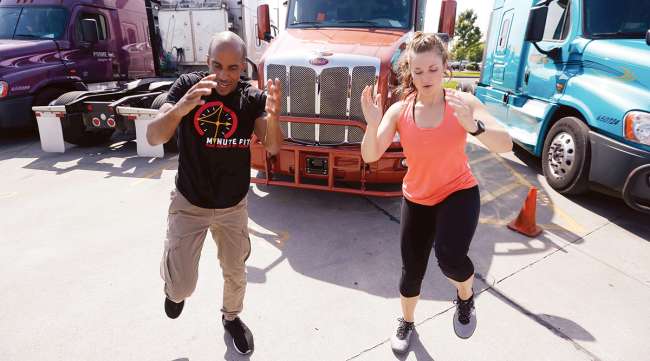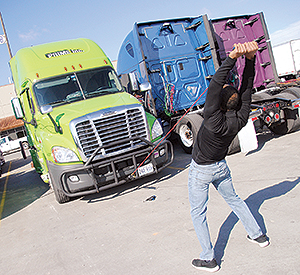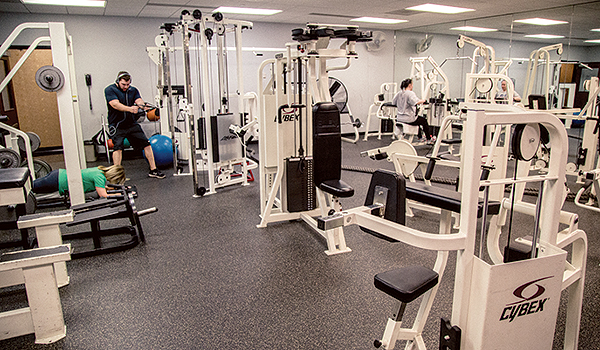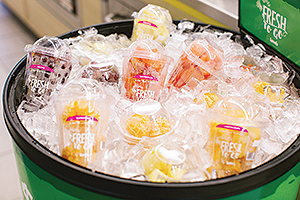Special to Transport Topics
Options Abound for Elevating Drivers’ Health and Wellness

[Stay on top of transportation news: Get TTNews in your inbox.]
In the three years that Christopher Bundock has worked for Prime Inc. as a truck driver, he has gained close to 100 pounds.
And he’s not alone.
When sitting behind the wheel for long stretches at a time, with little chance to exercise and few nutritious options on the road, it’s little wonder that truckers’ obesity rates are nearly two times higher than the general population, according to a 2010 study by the National Institute for Occupational Safety and Health. And with obesity comes greater risks for diabetes, heart disease and hypertension.
Fortunately, there is a wellness movement on the rise aimed at improving the health of truckers, though the challenge remains to educate and motivate.
Siphiwe Baleka knows firsthand the inherent risks of the profession. He was a world-class swimmer in college and always had been physically fit. Within two months after starting a job as a longhaul truck driver, he gained more than 10% of his body weight.
“It didn’t take a rocket scientist to see I could be 100 pounds overweight in three years; I didn’t want to end up like that,” he said.

Baleka demonstrates an exercise. (Courtesy of Siphiwe Baleka)
Baleka tried multiple fitness and nutrition plans, but when nothing seemed to work, he spent several years researching and developing his own. Today, his company, Fitness Trucking, offers driver health and fitness programs, the most popular being the 13 Week Program.
“We teach the drivers how to turn their fat-burning system on before they start their shift by doing a workout that is 15 minutes or less that doesn’t require any equipment, can be done in the shower, inside or outside of the truck, or anywhere with 2 feet of space,” Baleka said.
Drivers also maintain a nutrition log, but Baleka said the drivers’ diets do not need to be overhauled.
“We’ll show a driver how to keep eating at the truck stops and fast-food places but make strategic and effective changes and substitutions to lose weight.”
He provides 13 weeks of coaching until they master the system and develop new behavior habits.
It has worked like a charm for Bundock, who already lost 58 pounds in three months. “It’s a quick workout about 15 to 20 minutes long. You get your maximum heart rate up to where it’s boosting your metabolism at its peak. I’m way more energetic and motivated,” he said.
“If you want it, you’re going to schedule time to make it happen. You’ll wake up the hour early to get up, get yourself together, do the program and prep your food for the day,” Bundock added.
Based on data showing that it takes only four minutes to switch on your fat-burning system, the next part of the program is the 4 Minute Fit technique.
“[The objective] is to instill in the driver the habit of turning their metabolism on before they start driving and keeping it on while driving,” Baleka said. Once metabolism gets going, drivers need to eat protein every three hours.
Another driver wellness option is Rolling Strong, which offers a menu of tools that can be used to manage health and reduce obesity risks.
If you want it, you're going to schedule time to make it happen. You'll wake up the hour early to get up, get yourself together, do the program and prep your food for the day.
Christopher Bundock, Prime Inc. driver, on Siphiwe Baleka's 13-Week Program
“We have a strong mobile tech presence, a mobile app that is robust and powerful, a rewards and marketing platform, online coaching, our own exercise and fitness routines specific for truck drivers, and have developed our own database points of interest to help drivers at the end of the day to find healthy options and workout facilities,” said Stephen Kane, president of the Riverside, Mo.-based company.
Kane further explained that Rolling Strong is interactive for users. Drivers can track “points” for exercise and can redeem a voucher in the app and walk into a drug store to get screenings. It also includes a “predict a meal” feature that allows drivers to determine what they should eat based on their biometric allowance. The program is supported by coaches who create podcasts, workout videos and other content to give drivers more direction.
Kane was inspired to develop this program because of a health scare. Not only did he battle cancer but, as an operations manager for various motor carriers, he witnessed close friends die young from chronic conditions prevalent among the truck driver population.
“We take the approach that the No. 1 asset of the company is the driver; they also should be focused on the human being,” he said.
Claudia Rodriguez is the Rolling Strong coach for Mesilla Valley Transportation; she’s based in the El Paso, Texas, terminal but visits three other terminals monthly to conduct driver health assessments.
“So many of them that want to create those changes and don’t know how. If they want to stay healthy, they really have to go out of their way and be deliberate with their actions. I’m there to guide and help them,” she said.
Rodriguez focuses on driver education and creates internal competitions and challenges to help motivate the participants. She reported that many participants have not only lost weight but have lowered their blood pressure significantly.
Among them is Jacob Martinez. On the job for a year, he once got severely dehydrated to the point of vomiting while driving through desert-like temperatures in California.

Mesilla Valley Transportation driver Jacob Martinez receives a $200 reward card for Excellence in Driver Wellness from Rolling Strong. Martinez said he enjoys tracking his points for fitness and nutrition. (Rolling Strong)
After signing up with Rolling Strong he said, “I keep myself more hydrated, maintain my calories better and maintain my sleep better.”
He likes tracking the points for fitness and nutrition, and participating in the driver versus driver MVT fall competition keeps him motivated.
“It’s made a difference in my life,” he said.
Prime Inc., based in Springfield, Mo., hired Matthew Hancock to be its driver health and fitness coordinator. Acknowledging that health and wellness isn’t a one-size-fits-all approach, Hancock offers several resources to drivers, from healthy in-truck recipes to manageable exercises. He leverages technology to communicate all aspects of the program to the drivers, who can download the company app and pull up an exclusive website to access fitness programs.
“We just started an Instagram page to showcase our drivers that are getting healthier and showing ways to do so on the road,” said Hancock, who added that he’ll start putting videos on the company’s YouTube channel.
Hancock also has devised a system of simple but effective in-truck exercises, such as using a mat for push-ups, sit-ups and squats, along with using adjustable dumbbells.
“It is all about keeping it sustainable and attainable. They probably won’t run 3 miles, but I’ll tell them to park further from the truck stop and take a few laps around,” he said.

Drivers work out at a gym at a Prime Inc. terminal. The gyms also offer full-court basketball. (Prime Inc.)
For those who want more cardio, he’ll give them more complex routines.
“One stat I threw out is that 32 times around the truck and trailer equal a mile; if they do it once a day, that is 7 miles a week,” he said.
Prime’s terminals also contain gyms that offer full-court basketball and cardio and weightlifting equipment.
Driver Wellness at Truck Stops
Truck stops also are striving to provide better nutrition and exercise options for the professional drivers who visit their facilities.
TravelCenters of America, for instance, created the StayFit program a decade ago. Scattered across 260 locations, offerings include 61 indoor fitness rooms, walking-trail maps at 171 locations and medical facilities at 24 locations. Other options include basketball courts, horseshoe pits and beanbag toss games.
“The drivers who are active love them. Some organize walks, some ride bikes, others use our facilities on a regular basis,” said Tom Liukus, TA’s senior vice president of marketing and public relations.
The company also marks 77 consumer-packaged goods with the StayFit label, while some on-site restaurants offer healthier items.
In response to demand, Love’s Travel Stops & Country Stores provides fresh fruit at its 500-plus stores. Whit Harson, senior manager of category management and deli, said there is a demand for healthy options.

Fresh fruit on display at a Love's store. (Shutterstock)
“There is no question that drivers are looking for healthier choices and things they can take in the truck and eat easily,” he said. To that end, Love’s offers a fresh salad option as well as protein-packed to-go items.
UrgentCareTravel is a nationwide network of walk-in medical clinics located at Pilot Flying J travel centers.
“UrgentCareTravel has conducted more than 25,000 [Department of Transportation] physicals and found that 48% of professional truck drivers receive a one-year-or-less commercial driver’s license due to chronic conditions, including diabetes, hypertension and obesity,” said Mitch Strobin, senior vice president of marketing and relationship management.
The truck stop operator partners with Active and Fit Direct to provide access to a network of more than 10,000 fitness centers for $25 per month and offers drivers an opportunity to participate in the SleepCharge program, which monitors sleep health.
“We also provide all of our team members access to our employee assistance program, lifestyle and disease management assistance, and coaching with Livongo, and a well-being Fuel4Life app that has challenges and rewards to encourage positive sleep, physical activity, nutrition, financial and emotional well-being habits,” said Diana Morgan, director of benefits.
An Achievable Goal
Despite the odds, driver health and wellness does not have to be an oxymoron. Changing the mindset as to what is doable on the road may be the first step.
“The big problem is that a lot of us, including drivers, have a misconception that you have to exercise for 30 minutes or an hour at a time to have any sort of health benefits for weight loss,” Prime’s Hancock said. “Although the recommended amount of exercise is 150 minutes per week, you can break this large chunk up into small segments throughout the day. One thing I do with our drivers at Prime is to teach them to view their day differently and to change their perspective on what they do during those small breaks.”
He added that it doesn’t have to equate to much more than four to five minutes of exercise on two to three breaks a day.
Since implementing the program, Hancock said the company has seen drivers gravitate toward living a healthier lifestyle, which, he said, “can pay huge dividends for helping our truck drivers live longer, safer and healthier lives.”
Fitness Trucking’s Baleka said, “Not only is health and fitness an achievable goal for the truck driver population as a whole, we know exactly what to do and how to transform the industry already. [The four-minute fit program is] actually way easier to do than everyone thinks. We have to change the values of the drivers or increase how much they value their health and staying fit.”
Kane said his company’s goal is to someday view the driver population as a healthy population.
“That is achievable, because we have a subportion that has become healthy,” he said. “That is our end goal: to help the driver.”
Want more news? Listen to today's daily briefing:




